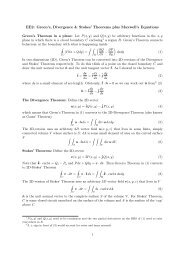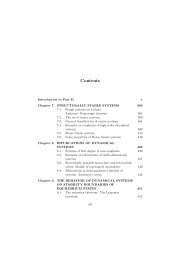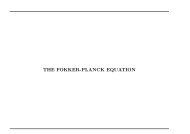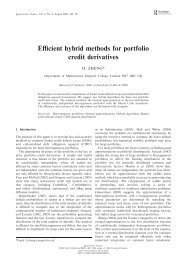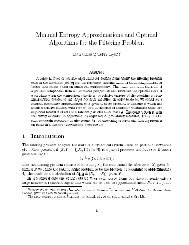Blood Flow in the Rabbit Aortic Arch and Descending Thoracic Aorta
Blood Flow in the Rabbit Aortic Arch and Descending Thoracic Aorta
Blood Flow in the Rabbit Aortic Arch and Descending Thoracic Aorta
Create successful ePaper yourself
Turn your PDF publications into a flip-book with our unique Google optimized e-Paper software.
<strong>Blood</strong> <strong>Flow</strong> <strong>in</strong> <strong>the</strong> <strong>Rabbit</strong> <strong>Aortic</strong> <strong>Arch</strong><br />
<strong>and</strong> Descend<strong>in</strong>g <strong>Thoracic</strong> <strong>Aorta</strong><br />
P. E. V<strong>in</strong>cent a† A. M. Plata a A. A. E. Hunt b<br />
P. D. We<strong>in</strong>berg b S. J. Sherw<strong>in</strong> a<br />
a Department of Aeronautics, Imperial College London, South Kens<strong>in</strong>gton, London,<br />
UK, SW7 2AZ<br />
b Department of Bioeng<strong>in</strong>eer<strong>in</strong>g, Imperial College London, South Kens<strong>in</strong>gton,<br />
London, UK, SW7 2AZ<br />
† Current Address: Department of Aeronautics <strong>and</strong> Astronautics, Stanford<br />
University, Stanford, California, USA, 94305<br />
Abstract<br />
The distribution of a<strong>the</strong>rosclerotic lesions with<strong>in</strong> <strong>the</strong> rabbit vasculature, par-<br />
ticularly with<strong>in</strong> <strong>the</strong> descend<strong>in</strong>g thoracic aorta, has been mapped <strong>in</strong> numerous<br />
studies. The patchy nature of such lesions has been attributed to local variation<br />
<strong>in</strong> <strong>the</strong> pattern of blood flow. However, <strong>the</strong>re have been few attempts to model<br />
1
<strong>and</strong> characterise <strong>the</strong> flow. In this study a high-order cont<strong>in</strong>uous Galerk<strong>in</strong> f<strong>in</strong>ite<br />
element method was used to simulate blood flow with<strong>in</strong> a realistic representa-<br />
tion of <strong>the</strong> rabbit aortic arch <strong>and</strong> descend<strong>in</strong>g thoracic aorta. The geometry,<br />
which was obta<strong>in</strong>ed from computed tomography of a res<strong>in</strong> corrosion cast, <strong>in</strong>-<br />
cluded all vessels orig<strong>in</strong>at<strong>in</strong>g from <strong>the</strong> aortic arch (followed to at least <strong>the</strong>ir<br />
second generation) <strong>and</strong> five pairs of <strong>in</strong>tercostal arteries orig<strong>in</strong>at<strong>in</strong>g from <strong>the</strong><br />
proximal descend<strong>in</strong>g thoracic aorta. The simulations showed that small geo-<br />
metrical undulations associated with <strong>the</strong> ductus arteriosus scar cause significant<br />
deviations <strong>in</strong> wall shear stress (WSS). This highlights <strong>the</strong> importance of geo-<br />
metrical accuracy when analys<strong>in</strong>g WSS or related metrics. It was also observed<br />
that two Dean-type vortices form <strong>in</strong> <strong>the</strong> aortic arch <strong>and</strong> propagate down <strong>the</strong><br />
descend<strong>in</strong>g thoracic aorta (along with an associated skewed axial velocity pro-<br />
file). This leads to <strong>the</strong> occurrence of axial streaks <strong>in</strong> WSS, similar <strong>in</strong> nature<br />
to <strong>the</strong> streaks of lipid deposition found <strong>in</strong> <strong>the</strong> descend<strong>in</strong>g aorta of cholesterol-<br />
fed rabbits. F<strong>in</strong>ally, it was observed that WSS patterns with<strong>in</strong> <strong>the</strong> vic<strong>in</strong>ity of<br />
<strong>in</strong>tercostal branch ostia depend not only on local flow features caused by <strong>the</strong><br />
branches <strong>the</strong>mselves but also on larger-scale flow features with<strong>in</strong> <strong>the</strong> descend<strong>in</strong>g<br />
aorta, which vary between branches at different locations. This result implies<br />
that disease <strong>and</strong> WSS patterns are best compared on a branch-by-branch basis.<br />
2
1 Introduction<br />
The prevalence of a<strong>the</strong>rosclerosis varies with<strong>in</strong> <strong>the</strong> mammalian vasculature, particu-<br />
larly <strong>in</strong> regions of arterial branch<strong>in</strong>g <strong>and</strong> curvature. S<strong>in</strong>ce <strong>the</strong>se regions are associated<br />
with complex blood flow patterns, it has been postulated that blood flow may play<br />
an important role <strong>in</strong> regulat<strong>in</strong>g a<strong>the</strong>rogenesis. Fry [1] <strong>in</strong>ferred from studies of hy-<br />
percholesterolaemic animals that lesions develop <strong>in</strong> regions of high wall shear stress<br />
(WSS). Caro, Fitz-Gerald <strong>and</strong> Schroter [2, 3], who studied human post mortem ma-<br />
terial, <strong>in</strong>stead suggested that regions of arteries experienc<strong>in</strong>g low WSS are prone to<br />
disease. The proposed mechanisms were, respectively, <strong>in</strong>creased lipoprote<strong>in</strong> <strong>in</strong>flux<br />
<strong>in</strong>to <strong>the</strong> arterial wall, <strong>and</strong> decreased efflux of material made or modified with<strong>in</strong> <strong>the</strong><br />
wall.<br />
The low shear stress <strong>the</strong>ory of Caro, Fitz-Gerald <strong>and</strong> Schroter is widely accepted today<br />
(although <strong>the</strong> orig<strong>in</strong>al mechanism is contradicted by evidence that lesion prevalence<br />
depends on plasma LDL concentrations). However, a direct correlation between dis-<br />
ease patterns <strong>and</strong> WSS magnitude may be too simplistic. More complex relationships<br />
have been suggested, <strong>in</strong>clud<strong>in</strong>g <strong>the</strong> proposal that a comb<strong>in</strong>ation of low <strong>and</strong> temporally<br />
oscillat<strong>in</strong>g WSS predisposes to disease [4, 5, 6]. A better underst<strong>and</strong><strong>in</strong>g of arterial<br />
haemodynamics is required before def<strong>in</strong>itive correlations between flow <strong>and</strong> disease can<br />
be established. In recent years, underst<strong>and</strong><strong>in</strong>g has been enhanced by numerous com-<br />
putational studies [7, 8, 9, 10, 11, 12]. Such studies circumvent technical limitations<br />
associated with measur<strong>in</strong>g flow <strong>in</strong> vivo <strong>and</strong> facilitate <strong>the</strong> analysis of derived metrics<br />
such as WSS. However, despite numerous experimental studies of disease location <strong>in</strong><br />
<strong>the</strong> rabbit vasculature, <strong>the</strong>re have been few computational studies of blood flow <strong>in</strong><br />
3
this species <strong>and</strong> <strong>the</strong> correspond<strong>in</strong>g flow <strong>the</strong>refore rema<strong>in</strong>s largely uncharacterised.<br />
In <strong>the</strong> present study, a high-order cont<strong>in</strong>uous Galerk<strong>in</strong> f<strong>in</strong>ite element method was<br />
used to model blood flow with<strong>in</strong> a realistic representation of <strong>the</strong> rabbit aortic arch<br />
<strong>and</strong> descend<strong>in</strong>g thoracic aorta. The geometry was obta<strong>in</strong>ed from high-resolution com-<br />
puted tomography (CT) of a vascular cast. It <strong>in</strong>cluded all vessels orig<strong>in</strong>at<strong>in</strong>g from <strong>the</strong><br />
aortic arch (followed to at least <strong>the</strong>ir second generation) <strong>and</strong> five pairs of <strong>in</strong>tercostal<br />
arteries orig<strong>in</strong>at<strong>in</strong>g from <strong>the</strong> proximal descend<strong>in</strong>g thoracic aorta. Steady state flow<br />
of a Newtonian fluid was modelled with<strong>in</strong> <strong>the</strong> geometry, which was assumed to have<br />
rigid <strong>and</strong> stationary walls. These assumptions, which considerably simplified calcu-<br />
lations, clearly represent a significant approximation of <strong>in</strong> vivo conditions. However,<br />
<strong>the</strong>y permitted underst<strong>and</strong><strong>in</strong>g of <strong>the</strong> underly<strong>in</strong>g fluid dynamics, <strong>and</strong> did not prevent<br />
important new <strong>in</strong>formation be<strong>in</strong>g ga<strong>in</strong>ed due to <strong>the</strong> unprecedented detail <strong>and</strong> extent<br />
of <strong>the</strong> geometrical def<strong>in</strong>ition.<br />
2 Method - Obta<strong>in</strong><strong>in</strong>g a Geometrical Def<strong>in</strong>ition of<br />
<strong>the</strong> <strong>Rabbit</strong> <strong>Aorta</strong><br />
2.1 Overview<br />
The follow<strong>in</strong>g section details <strong>the</strong> process of obta<strong>in</strong><strong>in</strong>g a realistic geometrical def<strong>in</strong>ition<br />
<strong>and</strong> volume mesh of <strong>the</strong> rabbit aortic arch <strong>and</strong> descend<strong>in</strong>g thoracic aorta. The process<br />
consists of four stages: cast<strong>in</strong>g <strong>the</strong> rabbit vasculature, CT imag<strong>in</strong>g of <strong>the</strong> result<strong>in</strong>g<br />
cast, computational reconstruction of <strong>the</strong> CT data, <strong>and</strong> computational generation of<br />
4
a curved element volume mesh from <strong>the</strong> surface def<strong>in</strong>ition. Similar approaches have<br />
been employed <strong>in</strong> various previous studies [7][11]. However, to <strong>the</strong> authors’ knowledge,<br />
no previous studies have obta<strong>in</strong>ed geometrical def<strong>in</strong>itions with <strong>the</strong> comb<strong>in</strong>ed detail<br />
<strong>and</strong> extent of <strong>the</strong> one presented here.<br />
2.2 Cast<strong>in</strong>g Proceedure<br />
A male New Zeal<strong>and</strong> White rabbit aged 18 months <strong>and</strong> weigh<strong>in</strong>g 3.25kg received<br />
hepar<strong>in</strong> (2000 USP units, iv) <strong>and</strong> was <strong>the</strong>n euthanised with an overdose of sodium<br />
pentobarbitone (Euthatal, 160mg/kg, iv). A cannula was <strong>in</strong>serted <strong>and</strong> secured <strong>in</strong>to<br />
<strong>the</strong> cardiac left ventricle. It was used to flush <strong>the</strong> arterial system with sal<strong>in</strong>e <strong>and</strong><br />
<strong>the</strong>n to <strong>in</strong>fuse Batsons No. 17 cast<strong>in</strong>g material (Polysciences, Inc.) at a pressure<br />
of 95-100mmHg. This pressure, which is physiologically realistic for <strong>the</strong> rabbit [13],<br />
was ma<strong>in</strong>ta<strong>in</strong>ed until <strong>the</strong> cast<strong>in</strong>g material hardened <strong>and</strong> could no longer be <strong>in</strong>jected<br />
(at which po<strong>in</strong>t approximately 70ml had been used). Dur<strong>in</strong>g <strong>the</strong> <strong>in</strong>itial exo<strong>the</strong>rmic<br />
stage of <strong>the</strong> cur<strong>in</strong>g process, cold water was trickled through <strong>the</strong> chest <strong>and</strong> abdom<strong>in</strong>al<br />
cavities to dissipate heat. The cast<strong>in</strong>g material was <strong>the</strong>n left overnight to cure fully.<br />
The follow<strong>in</strong>g day, <strong>the</strong> rabbit carcass was submerged <strong>in</strong> a potassium hydroxide solu-<br />
tion (approximately 30% w/v). After two weeks <strong>the</strong> solution was renewed <strong>and</strong> left for<br />
a fur<strong>the</strong>r 24 hours. The second potassium hydroxide solution was <strong>the</strong>n replaced with<br />
a detergent solution <strong>and</strong> left for ano<strong>the</strong>r 24 hours. F<strong>in</strong>ally, <strong>the</strong> cast was removed from<br />
<strong>the</strong> detergent <strong>and</strong> gently washed with warm water. Images of <strong>the</strong> cast are shown <strong>in</strong><br />
Fig. 1. As an <strong>in</strong>dication of scale, <strong>the</strong> aortic root has a diameter of approximately<br />
6mm. All procedures complied with <strong>the</strong> U.K. Animals (Scientific Procedures) Act<br />
5
1986 <strong>and</strong> were approved by <strong>the</strong> Imperial College London local ethical review panel.<br />
2.3 Imag<strong>in</strong>g Proceedure<br />
The cast was imaged us<strong>in</strong>g a Metris X-Tek HMX-ST Micro-CT Scanner at <strong>the</strong> Natural<br />
History Museum, London, UK. A 2000 × 2000 × 2000 voxel cube of DICOM data<br />
(∼9.2GB) was obta<strong>in</strong>ed, with a voxel size of 55.2µm. Over 100 voxels spanned <strong>the</strong><br />
6-mm diameter of <strong>the</strong> aortic root.<br />
2.4 Obta<strong>in</strong><strong>in</strong>g a Surface Def<strong>in</strong>ition<br />
An <strong>in</strong>tensity isosurface was extracted from <strong>the</strong> DICOM data us<strong>in</strong>g Amira 5.2.0 (Vis-<br />
age Imag<strong>in</strong>g, Inc.) The surface was cropped us<strong>in</strong>g <strong>the</strong> Vascular Modell<strong>in</strong>g Tool Kit<br />
(VMTK) to remove unwanted arteries. <strong>Flow</strong> extensions term<strong>in</strong>at<strong>in</strong>g with a circu-<br />
lar cross section were <strong>the</strong>n extruded from each outflow vessel us<strong>in</strong>g VMTK, to fa-<br />
cilitate <strong>the</strong> application of boundary conditions. F<strong>in</strong>ally, <strong>the</strong> surface was smoo<strong>the</strong>d<br />
us<strong>in</strong>g VMTK. The degree of smooth<strong>in</strong>g was highly limited <strong>in</strong> order to avoid loss of<br />
small-scale geometrical features. Images of <strong>the</strong> f<strong>in</strong>al surface def<strong>in</strong>ition, <strong>in</strong>clud<strong>in</strong>g flow<br />
extensions, are shown <strong>in</strong> Fig. 2.<br />
2.5 Obta<strong>in</strong><strong>in</strong>g a Volume Mesh<br />
The use of a high-order cont<strong>in</strong>uous Galerk<strong>in</strong> f<strong>in</strong>ite element method requires a com-<br />
putational doma<strong>in</strong> subdivided <strong>in</strong>to elements, with<strong>in</strong> which <strong>the</strong> solution is represented<br />
6
y a high-order polynomial expansion. S<strong>in</strong>ce each element holds multiple degrees<br />
of freedom, <strong>the</strong> volume mesh can be coarse compared to a typical low-order f<strong>in</strong>ite<br />
element or f<strong>in</strong>ite volume mesh. In this study, a volume mesh of 79,847 tetrahedral el-<br />
ements <strong>and</strong> 25,498 prismatic elements was constructed us<strong>in</strong>g Gambit 2.4.6 <strong>and</strong> Tgrid<br />
4.0.24 (ANSYS, Inc). The size of <strong>the</strong> elements was based on <strong>the</strong> local curvature of<br />
<strong>the</strong> surface def<strong>in</strong>ition. The prismatic elements were placed adjacent to <strong>the</strong> lum<strong>in</strong>al<br />
surface of <strong>the</strong> arterial wall <strong>in</strong> order to improve resolution of any momentum boundary<br />
layers that formed. External faces of prismatic boundary elements were curved us<strong>in</strong>g<br />
SPHERIGON patches [14], follow<strong>in</strong>g <strong>the</strong> approach of Gr<strong>in</strong>berg et al. [15], so that<br />
<strong>the</strong>y accurately approximated <strong>the</strong> surface def<strong>in</strong>ition despite <strong>the</strong>ir large size. Sections<br />
of <strong>the</strong> result<strong>in</strong>g volume mesh are shown <strong>in</strong> Fig. 3.<br />
3 Method - Simulat<strong>in</strong>g <strong>Blood</strong> <strong>Flow</strong> with<strong>in</strong> <strong>the</strong> Rab-<br />
bit <strong>Aorta</strong><br />
3.1 Govern<strong>in</strong>g Equations<br />
<strong>Blood</strong> flow was modelled us<strong>in</strong>g <strong>the</strong> <strong>in</strong>compressible steady-state Navier-Stokes equa-<br />
tions for a Newtonian fluid, which can be written as<br />
∇ · u = 0, (1)<br />
µ∇ 2 u − ρu · ∇u = ∇p, (2)<br />
7
where µ is <strong>the</strong> viscosity of rabbit blood, ρ is <strong>the</strong> density of rabbit blood, u is <strong>the</strong> three-<br />
dimensional velocity vector field with<strong>in</strong> <strong>the</strong> rabbit aorta <strong>and</strong> p is <strong>the</strong> pressure field<br />
with<strong>in</strong> <strong>the</strong> rabbit aorta. Such an approach has been adopted <strong>in</strong> numerous previous<br />
studies [10][12].<br />
3.2 Boundary Conditions<br />
A spatially uniform <strong>in</strong>flow velocity profile was prescribed at <strong>the</strong> aortic root. Apply-<br />
<strong>in</strong>g such a profile is an approximation, s<strong>in</strong>ce flow from <strong>the</strong> left ventricle is likely to<br />
be skewed <strong>and</strong> possess an <strong>in</strong>-plane component. Parabolic (fully developed) outflow<br />
profiles were prescribed perpendicular to all o<strong>the</strong>r boundaries, apart from <strong>the</strong> ma<strong>in</strong><br />
outflow of <strong>the</strong> descend<strong>in</strong>g thoracic aorta, where a zero velocity gradient condition<br />
was prescribed perpendicular to <strong>the</strong> outflow plane. At <strong>the</strong> arterial wall, which was<br />
assumed to be rigid <strong>and</strong> stationary, a no-slip boundary condition was applied (i.e. all<br />
components of <strong>the</strong> velocity were set to zero).<br />
3.3 Parameter Values<br />
3.3.1 Reynolds Number<br />
For any viscous flow one can def<strong>in</strong>e a Reynolds number (Re), which quantifies <strong>the</strong><br />
ratio of <strong>in</strong>ertial to viscous forces act<strong>in</strong>g with<strong>in</strong> <strong>the</strong> fluid. In this study Re is def<strong>in</strong>ed<br />
as<br />
Re = ρV0D0<br />
µ , (3)<br />
8
where D0 is <strong>the</strong> hydraulic diameter of <strong>the</strong> aortic root <strong>in</strong>flow plane (<strong>the</strong> diameter of<br />
a circle with <strong>the</strong> same area as <strong>the</strong> aortic root <strong>in</strong>flow plane), <strong>and</strong> V0 is <strong>the</strong> spatially<br />
constant magnitude of <strong>the</strong> <strong>in</strong>flow velocity at <strong>the</strong> aortic root.<br />
The average flow rate <strong>in</strong>to <strong>the</strong> rabbit ascend<strong>in</strong>g thoracic aorta has been measured by<br />
Avolio et al. [13] to be 3.3mls −1 . These measurements were made us<strong>in</strong>g an electro-<br />
magnetic probe with an <strong>in</strong>ternal diameter of 5mm that caused “m<strong>in</strong>imal constriction”<br />
of <strong>the</strong> ascend<strong>in</strong>g aorta. Assum<strong>in</strong>g that <strong>the</strong> arterial wall thickness was 7% of <strong>the</strong> ves-<br />
sel diameter (this is constant across many species <strong>and</strong> vessels [16]), <strong>the</strong>n <strong>the</strong> <strong>in</strong>flow<br />
area was ∼ 15mm 2 <strong>and</strong> <strong>the</strong> measured <strong>in</strong>flow rate corresponds to an <strong>in</strong>flow velocity<br />
magnitude of ∼ 0.22ms −1 . The peak <strong>in</strong>flow velocity magnitude measured by Avolio<br />
et al. [13] was 0.927ms −1 . In <strong>the</strong> present study three values of <strong>in</strong>flow velocity mag-<br />
nitude V0 were considered. Specifically V0 = 0.0332ms −1 (an arbitrary low value),<br />
V0 = 0.199ms −1 (based on <strong>the</strong> mean flow rate measurements of Avolio et al. [13]),<br />
<strong>and</strong> V0 = 0.862ms −1 (based on <strong>the</strong> peak flow rate measurements of Avolio et al. [13]).<br />
Assum<strong>in</strong>g that ρ = 1.044 × 10 3 kgm −3 [17], µ = 4.043 × 10 −3 kgm −1 s −1 [18] <strong>and</strong><br />
D0 = 5.838 × 10 −3 m (measured from <strong>the</strong> geometry), <strong>the</strong>se values of V0 lead to round<br />
values Re = 50, Re = 300 <strong>and</strong> Re = 1300 respectively.<br />
3.3.2 <strong>Flow</strong> Splits<br />
<strong>Flow</strong> splits <strong>in</strong>to <strong>the</strong> <strong>in</strong>nom<strong>in</strong>ate artery <strong>and</strong> <strong>the</strong> left subclavian artery were based on <strong>the</strong><br />
measurements of Barakat, Mar<strong>in</strong>i <strong>and</strong> Colton [19]. Specifically, 14.7% of <strong>the</strong> <strong>in</strong>flow<br />
at <strong>the</strong> aortic root went <strong>in</strong>to <strong>the</strong> <strong>in</strong>nom<strong>in</strong>ate artery <strong>and</strong> 7.1% <strong>in</strong>to <strong>the</strong> left subclavian<br />
artery. <strong>Flow</strong> splits for all subsequent branches of <strong>the</strong>se arteries were determ<strong>in</strong>ed<br />
9
us<strong>in</strong>g Murray’s law [20], which states that <strong>the</strong> flow <strong>in</strong> a vessel is proportional to <strong>the</strong><br />
diameter of <strong>the</strong> vessel cubed. It was assumed that on average each <strong>in</strong>tercostal branch<br />
received 0.2% of <strong>the</strong> flow enter<strong>in</strong>g <strong>the</strong> descend<strong>in</strong>g thoracic aorta. This value sits<br />
with<strong>in</strong> <strong>the</strong> range considered by Kazakidi et al. [21] but is o<strong>the</strong>rwise arbitrary. The ten<br />
<strong>in</strong>tercostal branches <strong>the</strong>refore received between <strong>the</strong>m a total of 2% of <strong>the</strong> flow enter<strong>in</strong>g<br />
<strong>the</strong> descend<strong>in</strong>g thoracic aorta (which is equivalent to 1.56% of <strong>the</strong> flow enter<strong>in</strong>g at <strong>the</strong><br />
aortic root). The exact split of this aggregate flow between <strong>the</strong> <strong>in</strong>dividual <strong>in</strong>tercostal<br />
branches was once aga<strong>in</strong> determ<strong>in</strong>ed us<strong>in</strong>g Murray’s law.<br />
3.4 Numerical Method<br />
The <strong>in</strong>compressible steady-state Navier-Stokes equations were solved with<strong>in</strong> <strong>the</strong> ar-<br />
terial geometry us<strong>in</strong>g a high-order cont<strong>in</strong>uous Galerk<strong>in</strong> method. This approach com-<br />
b<strong>in</strong>es <strong>the</strong> superior accuracy of spectral methods with <strong>the</strong> geometrical flexibility of<br />
low-order f<strong>in</strong>ite element or f<strong>in</strong>ite volume schemes. For fur<strong>the</strong>r details of <strong>the</strong> method<br />
see papers by Sherw<strong>in</strong> et al. [22, 23], <strong>the</strong> textbook by Karniadakis <strong>and</strong> Sherw<strong>in</strong> [24],<br />
<strong>and</strong> references <strong>the</strong>re<strong>in</strong>.<br />
Convergence of <strong>the</strong> solution was verified by perform<strong>in</strong>g simulations at Re = 300 us<strong>in</strong>g<br />
3 rd , 5 th <strong>and</strong> 7 th order polynomial expansions to represent <strong>the</strong> solution with<strong>in</strong> each<br />
element. S<strong>in</strong>ce <strong>the</strong> computational doma<strong>in</strong> conta<strong>in</strong>s 79,847 tetrahedral elements <strong>and</strong><br />
25,498 prismatic elements, use of <strong>the</strong>se expansions results <strong>in</strong> a total of approximately<br />
3.07 × 10 6 , 1.37 × 10 7 , <strong>and</strong> 3.71 × 10 7 degrees of freedom respectively (account<strong>in</strong>g<br />
for vertex, edge <strong>and</strong> face multiplicity, <strong>and</strong> count<strong>in</strong>g each of <strong>the</strong> velocity components<br />
<strong>and</strong> <strong>the</strong> pressure as separate degrees of freedom). When switch<strong>in</strong>g from 3 rd order<br />
10
to 5 th order solution polynomials, <strong>the</strong> total wall force changed by 0.019%, <strong>and</strong> when<br />
switch<strong>in</strong>g from 5 th order to 7 th order solution polynomials, <strong>the</strong> total wall force changed<br />
by 0.0040%. The solution was <strong>the</strong>refore deemed to have converged when us<strong>in</strong>g 5 th<br />
order polynomials with<strong>in</strong> each element, <strong>and</strong> thus all presented results were obta<strong>in</strong>ed<br />
us<strong>in</strong>g this order. For comparison with a more st<strong>and</strong>ard low-order calculation, this<br />
corresponds (<strong>in</strong> terms of degrees of freedom) to us<strong>in</strong>g a mesh of approximately 2.05 ×<br />
10 7 l<strong>in</strong>ear tetrahedral elements. However, such as scheme will only be 2 nd order<br />
accurate <strong>in</strong> space, whereas <strong>the</strong> scheme employed here is nom<strong>in</strong>ally 6 th order accurate.<br />
4 Results <strong>and</strong> Analysis<br />
4.1 <strong>Flow</strong> <strong>in</strong> <strong>the</strong> <strong>Aortic</strong> <strong>Arch</strong><br />
Figs. 4(a) <strong>and</strong> 4(c) show streaml<strong>in</strong>es <strong>in</strong> <strong>the</strong> aortic arch when Re = 300. Significant<br />
secondary flow was observed. The streaml<strong>in</strong>es are qualitatively comparable with<br />
those obta<strong>in</strong>ed by Barakat, Kar<strong>in</strong>o <strong>and</strong> Colton us<strong>in</strong>g microc<strong>in</strong>ematographic methods<br />
<strong>in</strong> excised rabbit aortas [25]. Figs. 4(b) <strong>and</strong> 4(d) show coherent vortical structures<br />
<strong>in</strong> <strong>the</strong> aortic arch when Re = 300. The structures were def<strong>in</strong>ed by isosurfaces of<br />
<strong>the</strong> widely-used metric λ2 [26], which accurately identifies vortices at low Reynolds<br />
numbers (unlike m<strong>in</strong>imum-pressure criteria). Two Dean type vortices [27] of unequal<br />
magnitude formed. This is consistent with <strong>the</strong> literature on flow <strong>in</strong> curved pipes<br />
[28], <strong>and</strong> with studies of flow <strong>in</strong> <strong>the</strong> aortic arch of mice [11] <strong>and</strong> human subjects<br />
[12]. However, to <strong>the</strong> knowledge of <strong>the</strong> authors, formation of such vortices has not<br />
previously been demonstrated with<strong>in</strong> <strong>the</strong> aortic arch of rabbits. Results for Re = 1300<br />
11
(not shown) were qualitatively similar. However, at Re = 50 (results not shown)<br />
<strong>the</strong>re was m<strong>in</strong>imal secondary flow with<strong>in</strong> <strong>the</strong> arch <strong>and</strong> no significant Dean vortices<br />
developed.<br />
Figs. 5 <strong>and</strong> 6 show maps of WSS with<strong>in</strong> <strong>the</strong> aortic arch for all three values of Re<br />
considered. The patterns are complex <strong>and</strong> become <strong>in</strong>creas<strong>in</strong>gly heterogeneous as Re<br />
is <strong>in</strong>creased. Two important observations can be made. The first is that, due to <strong>the</strong><br />
complexity of <strong>the</strong> patterns, it would be <strong>in</strong>correct to characterise <strong>the</strong> <strong>in</strong>ner curvature<br />
of <strong>the</strong> arch as a ‘low shear region’ <strong>and</strong> <strong>the</strong> outer curvature as a ‘high shear region’ (as<br />
is common when <strong>in</strong>terpret<strong>in</strong>g experimental data). The second is that small surface<br />
undulations associated with <strong>the</strong> ductus arteriosus scar, whilst hav<strong>in</strong>g a negligible<br />
effect on flow, <strong>in</strong>duce significant deviations <strong>in</strong> WSS, comparable to those caused by<br />
vascular scale flow features. The deviations are marked with arrows <strong>in</strong> Figs. 5 <strong>and</strong><br />
6. This observation highlights <strong>the</strong> critical importance of geometrical accuracy when<br />
calculat<strong>in</strong>g <strong>and</strong> analys<strong>in</strong>g WSS or related metrics. Interest<strong>in</strong>gly, Duff [29] suggests<br />
that <strong>the</strong> ductus arteriosus scar is a site of a<strong>the</strong>rosclerotic disease <strong>in</strong> humans.<br />
4.2 <strong>Flow</strong> <strong>in</strong> <strong>the</strong> Proximal Descend<strong>in</strong>g <strong>Thoracic</strong> <strong>Aorta</strong><br />
Fig. 7 shows plots of axial velocity <strong>and</strong> vorticity magnitude with<strong>in</strong> <strong>the</strong> descend<strong>in</strong>g<br />
thoracic aorta when Re = 300. The axial velocity profile is skewed to one side,<br />
<strong>and</strong> <strong>the</strong> two Dean-type vortices emerg<strong>in</strong>g from <strong>the</strong> aortic arch cont<strong>in</strong>ue to propagate<br />
down <strong>the</strong> descend<strong>in</strong>g thoracic aorta. Fig. 8 shows streaml<strong>in</strong>es <strong>in</strong> <strong>the</strong> descend<strong>in</strong>g<br />
thoracic aorta for all three values of Re considered. The results were obta<strong>in</strong>ed us<strong>in</strong>g<br />
<strong>the</strong> particle track<strong>in</strong>g approach of Copella et al. [30], which was devised specifically<br />
12
for post-process<strong>in</strong>g <strong>the</strong> results of unstructured high-order f<strong>in</strong>ite element simulations.<br />
When Re = 50 <strong>the</strong>re is almost no secondary flow with<strong>in</strong> <strong>the</strong> descend<strong>in</strong>g thoracic<br />
aorta, s<strong>in</strong>ce significant Dean-type vortices do not form <strong>in</strong> <strong>the</strong> aortic arch. However,<br />
when Re = 300 <strong>and</strong> Re = 1300, vortices are clearly present. Also, it is apparent from<br />
Fig. 8 that <strong>the</strong> streaml<strong>in</strong>e colours, which were uniformly distributed at <strong>the</strong> aortic<br />
root, become <strong>in</strong>creas<strong>in</strong>gly mixed as Re is <strong>in</strong>creased. Hence, rais<strong>in</strong>g Re <strong>in</strong>creases <strong>the</strong><br />
degree of stirr<strong>in</strong>g to which blood is subjected as it travels through <strong>the</strong> aortic arch <strong>and</strong><br />
down <strong>the</strong> descend<strong>in</strong>g thoracic aorta.<br />
Fig. 9 shows maps of WSS <strong>in</strong> <strong>the</strong> descend<strong>in</strong>g thoracic aorta for all three values of Re<br />
considered. When Re = 300 <strong>and</strong> Re = 1300, <strong>the</strong> WSS patterns exhibit streaks due<br />
to <strong>the</strong> presence of a skewed axial velocity profile. Fig. 10 shows en face flattened<br />
three-colour maps of WSS <strong>in</strong> <strong>the</strong> descend<strong>in</strong>g thoracic aorta. In all cases <strong>the</strong> aorta was<br />
unwrapped via a ‘computational <strong>in</strong>cision’ along <strong>the</strong> ventral aortic wall, <strong>and</strong> <strong>the</strong> colour<br />
maps are presented with <strong>the</strong> lum<strong>in</strong>al surface fac<strong>in</strong>g upwards. Streaks of high <strong>and</strong> low<br />
WSS are aga<strong>in</strong> clearly visible when Re = 300 <strong>and</strong> Re = 1300. These streaks can<br />
be compared with <strong>the</strong> streaks of fat deposition observed <strong>in</strong> <strong>the</strong> descend<strong>in</strong>g aorta of<br />
cholesterol-fed rabbits (Fig. 11). Whilst detailed quantitative comparisons between<br />
Fig. 10 <strong>and</strong> Fig. 11 are unwarranted at this stage (due to <strong>the</strong> small sample sizes), it is<br />
clear that a correlation between WSS <strong>and</strong> disease may exist. Systematic comparison<br />
of several computational <strong>and</strong> experimental results is necessary to ascerta<strong>in</strong> <strong>in</strong> more<br />
detail <strong>the</strong> nature of any correlation.<br />
13
4.3 <strong>Flow</strong> <strong>in</strong>to <strong>the</strong> Intercostal Arteries<br />
Fig. 12 shows plots of WSS <strong>in</strong> <strong>the</strong> vic<strong>in</strong>ity of various <strong>in</strong>tercostal branch ostia for all<br />
three values of Re considered. The patterns reflect a superposition of both ‘local’<br />
<strong>and</strong> ‘global’ contributions. The local contributions are caused by <strong>the</strong> deflection of<br />
aortic flow <strong>in</strong>to <strong>the</strong> branches <strong>the</strong>mselves. Such contributions were studied <strong>in</strong> detail by<br />
Kazakidi, Sherw<strong>in</strong> <strong>and</strong> We<strong>in</strong>berg [21] with<strong>in</strong> idealised geometries, <strong>and</strong> are expected<br />
to be approximately <strong>in</strong>dependent of branch location. The global contributions result<br />
from bulk flow with<strong>in</strong> <strong>the</strong> descend<strong>in</strong>g thoracic aorta. When Re = 300 <strong>and</strong> Re = 1300<br />
<strong>the</strong>se global contributions exhibit streaks of high <strong>and</strong> low WSS, as discussed above.<br />
When Re = 50, <strong>the</strong> WSS patterns with<strong>in</strong> <strong>the</strong> vic<strong>in</strong>ity of each branch are approxi-<br />
mately <strong>in</strong>dependent of <strong>the</strong> branch location. This is because local contributions to <strong>the</strong><br />
WSS are approximately <strong>in</strong>dependent of branch location <strong>and</strong> <strong>the</strong>re is m<strong>in</strong>imal spatial<br />
variation <strong>in</strong> <strong>the</strong> global contribution. However, when Re = 300 <strong>and</strong> Re = 1300, <strong>the</strong><br />
WSS patterns with<strong>in</strong> <strong>the</strong> vic<strong>in</strong>ity of each branch become highly dependent on branch<br />
location, s<strong>in</strong>ce <strong>the</strong> global contribution now varies spatially. Note that as well as vary-<br />
<strong>in</strong>g between branch pairs, <strong>the</strong> global contributions to WSS also vary on <strong>the</strong> scale of<br />
<strong>the</strong> branch pairs <strong>the</strong>mselves. This can be seen by compar<strong>in</strong>g Figs. 12(d) <strong>and</strong> 12(f),<br />
which show <strong>the</strong> second <strong>and</strong> fourth pair of <strong>in</strong>tercostal branches, respectively, when<br />
Re = 300. In Fig. 12(d), one of <strong>the</strong> branches sits <strong>in</strong> a streak of high WSS, whereas<br />
<strong>the</strong> o<strong>the</strong>r sits on <strong>the</strong> edge of a low WSS streak. However, <strong>in</strong> Fig. 12(f), a streak of<br />
high WSS runs across <strong>the</strong> entrance to both branches.<br />
These f<strong>in</strong>d<strong>in</strong>gs are significant for three reasons. Firstly, <strong>the</strong>y challenge <strong>the</strong> accuracy<br />
14
of results obta<strong>in</strong>ed us<strong>in</strong>g models that do not <strong>in</strong>clude <strong>the</strong> spatially vary<strong>in</strong>g, large-scale<br />
aortic flow field [21]. Secondly, <strong>the</strong>y may expla<strong>in</strong> why disease patterns <strong>in</strong> <strong>the</strong> vic<strong>in</strong>-<br />
ity of <strong>in</strong>tercostal branch entrances vary between different branch locations. Thirdly,<br />
<strong>the</strong>y call <strong>in</strong>to question <strong>the</strong> process of comb<strong>in</strong><strong>in</strong>g disease patterns from <strong>in</strong>tercostal<br />
branches <strong>in</strong> different locations to obta<strong>in</strong> average maps [31]. It may be more appro-<br />
priate to analyse disease patterns, <strong>and</strong> compare <strong>the</strong>m with predicted WSS patterns,<br />
on a branch-by-branch basis.<br />
5 Conclusions<br />
A high-order cont<strong>in</strong>uous Galerk<strong>in</strong> f<strong>in</strong>ite element method was used to simulate blood<br />
flow with<strong>in</strong> a realistic representation of <strong>the</strong> rabbit aortic arch <strong>and</strong> descend<strong>in</strong>g thoracic<br />
aorta. Steady state flow of a Newtonian fluid was modelled with<strong>in</strong> <strong>the</strong> geometry,<br />
which was assumed to have rigid <strong>and</strong> stationary walls. These assumptions clearly<br />
represent a significant simplification of <strong>in</strong> vivo conditions. Never<strong>the</strong>less, <strong>the</strong> detail<br />
<strong>and</strong> extent of <strong>the</strong> geometrical def<strong>in</strong>ition allowed new <strong>and</strong> <strong>in</strong>terest<strong>in</strong>g results to be<br />
obta<strong>in</strong>ed. Firstly, small geometrical undulations associated with <strong>the</strong> ductus arteriosus<br />
scar caused significant deviations <strong>in</strong> WSS, highlight<strong>in</strong>g <strong>the</strong> importance of geometrical<br />
accuracy when analys<strong>in</strong>g WSS or related metrics. Secondly, two Dean-type vortices<br />
form <strong>in</strong> <strong>the</strong> aortic arch <strong>and</strong> (along with an associated skewed axial velocity profile)<br />
propagate down <strong>the</strong> descend<strong>in</strong>g thoracic aorta. This leads to <strong>the</strong> formation of axial<br />
streaks <strong>in</strong> WSS which are similar <strong>in</strong> nature to <strong>the</strong> streaks of early-stage a<strong>the</strong>rosclerosis<br />
observed to form <strong>in</strong> <strong>the</strong> descend<strong>in</strong>g aorta of cholesterol-fed rabbits. Thirdly, WSS<br />
patterns with<strong>in</strong> <strong>the</strong> vic<strong>in</strong>ity of <strong>in</strong>tercostal ostia depend not only on local flow features<br />
15
(caused by <strong>the</strong> branches <strong>the</strong>mselves), but also on larger-scale global flow features<br />
with<strong>in</strong> <strong>the</strong> descend<strong>in</strong>g aorta (which vary between ostia at different locations). This<br />
f<strong>in</strong>d<strong>in</strong>g has several implications. It challenges <strong>the</strong> accuracy of results obta<strong>in</strong>ed us<strong>in</strong>g<br />
models that do not <strong>in</strong>clude <strong>the</strong> spatially vary<strong>in</strong>g large-scale aortic flow field [21].<br />
It may also expla<strong>in</strong> why disease patterns <strong>in</strong> <strong>the</strong> vic<strong>in</strong>ity of <strong>in</strong>tercostal ostia vary<br />
between branch locations. F<strong>in</strong>ally, it calls <strong>in</strong>to question <strong>the</strong> process of comb<strong>in</strong><strong>in</strong>g<br />
disease patterns from branches at different locations <strong>in</strong> order to obta<strong>in</strong> average maps<br />
[31]; it may be more appropriate to analyse disease patterns, <strong>and</strong> compare <strong>the</strong>m with<br />
predicted WSS patterns, on a branch-by-branch basis.<br />
Future studies should build on <strong>the</strong> work presented <strong>in</strong> this paper to develop a detailed<br />
<strong>and</strong> holostic underst<strong>and</strong><strong>in</strong>g of blood flow with<strong>in</strong> <strong>the</strong> rabbit aortic arch <strong>and</strong> descend-<br />
<strong>in</strong>g thoracic aorta. Such an underst<strong>and</strong><strong>in</strong>g is required before def<strong>in</strong>itive correlations<br />
between blood flow patterns <strong>and</strong> a<strong>the</strong>rosclerosis can be established with certa<strong>in</strong>ty.<br />
In particular, future studies should <strong>in</strong>vestigate <strong>the</strong> effect of vary<strong>in</strong>g flow splits be-<br />
tween <strong>the</strong> aorta <strong>and</strong> its daughter vessels, <strong>the</strong> effect of us<strong>in</strong>g a more realistic <strong>in</strong>flow<br />
velocity profile at <strong>the</strong> aortic root, <strong>the</strong> effect of anatomical variation between animals,<br />
<strong>and</strong> <strong>the</strong> effect of <strong>in</strong>clud<strong>in</strong>g more complex physical phenomena, such as pulsatile flow,<br />
deformable walls, non-Newtonian rheology <strong>and</strong> <strong>the</strong> transport of dissolved solutes.<br />
16
Acknowledgments<br />
This study was funded by <strong>the</strong> Eng<strong>in</strong>eer<strong>in</strong>g <strong>and</strong> Physical Sciences Research Council,<br />
<strong>the</strong> Biotechnology <strong>and</strong> Biological Sciences Research Council, Fundación Caja Madrid,<br />
<strong>and</strong> a British Heart Foundation Research Excellence Award. The authors would<br />
like to thank Dr Richie Abel <strong>and</strong> Dr Stig Walsh for imag<strong>in</strong>g <strong>the</strong> cast, Dr Donal<br />
Taylor <strong>and</strong> Dr Leopold Gr<strong>in</strong>berg for assistance obta<strong>in</strong><strong>in</strong>g <strong>the</strong> high-order volume mesh,<br />
Miss Véronique Peiffer for assistance obta<strong>in</strong><strong>in</strong>g <strong>the</strong> unwrapped shear map images,<br />
Dr Stephanie Cremers for k<strong>in</strong>dly provid<strong>in</strong>g <strong>the</strong> disease images, <strong>and</strong> Professor Kim<br />
Parker for useful discussions. F<strong>in</strong>ally <strong>the</strong> authors would like to thank <strong>the</strong> high-<br />
performance comput<strong>in</strong>g staff at Imperial College London for <strong>the</strong>ir assistance, <strong>and</strong> <strong>the</strong><br />
Barcelona Supercomput<strong>in</strong>g Centre for use of <strong>the</strong>ir facilities (under HPC-EUROPA2<br />
project number 228398).<br />
17
References<br />
[1] D. L. Fry, Acute vascular endo<strong>the</strong>lial changes associated with <strong>in</strong>creased blood<br />
velocity gradients, Circ Res 22, 165 (1968).<br />
[2] C. G. Caro, J. M. Fitz-Gerald, <strong>and</strong> R. C. Schroter, Arterial wall shear <strong>and</strong><br />
distribution of early a<strong>the</strong>roma <strong>in</strong> man, Nature 223, 1159 (1969).<br />
[3] C. G. Caro, J. M. Fitz-Gerald, <strong>and</strong> R. C. Schroter, A<strong>the</strong>roma <strong>and</strong> arterial wall<br />
shear. Observation, correlation <strong>and</strong> proposal of a shear dependent mass transfer<br />
mechanism for a<strong>the</strong>rogenesis, Proc R Soc Lond B Biol Sci 177, 109 (1971).<br />
[4] D. N. Ku, D. P. Giddens, C. K. Zar<strong>in</strong>s, <strong>and</strong> S. Glagov, Pulsatile flow <strong>and</strong><br />
a<strong>the</strong>rosclerosis <strong>in</strong> <strong>the</strong> human carotid bifurcation. Positive correlation between<br />
plaque location <strong>and</strong> low oscillat<strong>in</strong>g shear stress, Arteriosclerosis 5, 293 (1985).<br />
[5] A. M. Shaaban <strong>and</strong> A. J. Duer<strong>in</strong>ckx, Wall shear stress <strong>and</strong> early a<strong>the</strong>rosclerosis:<br />
a review, Am J Roentgenol 174, 1657 (2000).<br />
[6] C. Cheng, R. de Crom, R. van Haperen, F. Helderman, G. B. Mousavi, L. C. A.<br />
van Damme, S. W. Kirschbaum, C. J. Slager, A. F. W. van der Steen, <strong>and</strong><br />
R. Krams, The role of shear stress <strong>in</strong> a<strong>the</strong>rosclerosis: action through gene ex-<br />
pression <strong>and</strong> <strong>in</strong>flammation, Cell Biochem Biophys 41, 279 (2004).<br />
[7] J. Suo, D. E. Ferrara, D. Sorescu, R. E. Guldberg, W. R. Taylor, <strong>and</strong> D. P.<br />
Giddens, Hemodynamic shear stresses <strong>in</strong> mouse aortas: Implications for a<strong>the</strong>ro-<br />
genesis, Arterioscl Throm Vas 27, 346 (2007).<br />
18
[8] Y. Huo, X. Guo, <strong>and</strong> G. S. Kassab, The flow field along <strong>the</strong> entire length of<br />
mouse aorta <strong>and</strong> primary branches, Ann Biomed Eng 36, 685 (2008).<br />
[9] N. Shahcheraghi, H. A. Dwyer, A. Y. Cheer, A. I. Barakat, <strong>and</strong> T. Rutaganira,<br />
Unsteady <strong>and</strong> three-dimensional simulation of blood flow <strong>in</strong> <strong>the</strong> human aortic<br />
arch, J Biomech Eng 124, 378 (2002).<br />
[10] X. Liu, Y. Fan, <strong>and</strong> X. Deng, Effect of spiral flow on <strong>the</strong> transport of oxygen <strong>in</strong><br />
<strong>the</strong> aorta: A numerical study, Ann Biomed Eng 38, 917 (2010).<br />
[11] A. Fe<strong>in</strong>tuch, P. Ruengsakulrach, A. L<strong>in</strong>, J. Zhang, Y. Q. Zhou, J. Bishop,<br />
L. Davidson, D. Courtman, F. S. Foster, D. A. Ste<strong>in</strong>man, R. M. Henkelman,<br />
<strong>and</strong> C. R. Ethier, Hemodynamics <strong>in</strong> <strong>the</strong> mouse aortic arch as assessed by MRI,<br />
ultrasound, <strong>and</strong> numerical model<strong>in</strong>g, Am J Physiol-Heart C 292, H884 (2007).<br />
[12] X. Liu, F. Pu, Y. Fan, X. Deng, D. Li, <strong>and</strong> S. Li, A numerical study on <strong>the</strong><br />
flow of blood <strong>and</strong> <strong>the</strong> transport of LDL <strong>in</strong> <strong>the</strong> human aorta: <strong>the</strong> physiological<br />
significance of <strong>the</strong> helical flow <strong>in</strong> <strong>the</strong> aortic arch, Am J Physiol-Heart C 297,<br />
H163 (2009).<br />
[13] A. P. Avolio, M. F. O’rourke, K. Mang, P. T. Bason, <strong>and</strong> B. S. Gow, A compar-<br />
ative study of pulsatile arterial hemodynamics <strong>in</strong> rabbits <strong>and</strong> gu<strong>in</strong>ea pigs, Am J<br />
Physiol 230, 868 (1976).<br />
[14] P. Vol<strong>in</strong>o <strong>and</strong> N. Magnenat-Thalmann, The Spherigon: a simple polygon patch<br />
for smooth<strong>in</strong>g quickly your polygonal meshes, <strong>in</strong> Proceed<strong>in</strong>gs of <strong>the</strong> Computer<br />
Animation, p. 72, Citeseer, 1998.<br />
19
[15] L. Gr<strong>in</strong>berg, T. Anor, J. R. Madsen, A. Yakhot, <strong>and</strong> G. Karniadakis, Large-scale<br />
simulation of <strong>the</strong> human arterial tree, Cl<strong>in</strong> Exp Pharmacol P 36, 194 (2009).<br />
[16] C. G. Caro, T. J. Pedley, R. C. Schroter, <strong>and</strong> W. A. Seed, The mechanics of <strong>the</strong><br />
circulation, Oxford university press, (1978).<br />
[17] T. Kenner, H. Leopold, <strong>and</strong> H. H<strong>in</strong>ghofer-Szalkay, The cont<strong>in</strong>uous high-precision<br />
measurement of <strong>the</strong> density of flow<strong>in</strong>g blood, Pflugers <strong>Arch</strong> 370, 25 (1977).<br />
[18] U. W<strong>in</strong>dberger, A. Bartholovitsch, R. Plasenzotti, K. J. Korak, <strong>and</strong> G. He<strong>in</strong>ze,<br />
Whole blood viscosity, plasma viscosity <strong>and</strong> erythrocyte aggregation <strong>in</strong> n<strong>in</strong>e mam-<br />
malian species: reference values <strong>and</strong> comparison of data, Exp Physiol 88, 431<br />
(2003).<br />
[19] A. I. Barakat, R. P. Mar<strong>in</strong>i, <strong>and</strong> C. Colton, Measurement of flow rates through<br />
aortic branches <strong>in</strong> <strong>the</strong> anes<strong>the</strong>tized rabbit, Lab Anim Sci 47, 184 (1997).<br />
[20] C. D. Murray, The physiological pr<strong>in</strong>ciple of m<strong>in</strong>imum work: I. The vascular<br />
system <strong>and</strong> <strong>the</strong> cost of blood volume, Proc Natl Acad Sci USA 12, 207 (1926).<br />
[21] A. Kazakidi, S. J. Sherw<strong>in</strong>, <strong>and</strong> P. D. We<strong>in</strong>berg, Effect of Reynolds number <strong>and</strong><br />
flow division on patterns of haemodynamic wall shear stress near branch po<strong>in</strong>ts<br />
<strong>in</strong> <strong>the</strong> descend<strong>in</strong>g thoracic aorta, J R Soc Interface 6, 539 (2009).<br />
[22] S. J. Sherw<strong>in</strong> <strong>and</strong> M. A<strong>in</strong>sworth, Unsteady Navier-Stokes solvers us<strong>in</strong>g hybrid<br />
spectral/hp element methods, Appl Numer Math 33, 357 (2000).<br />
[23] S. J. Sherw<strong>in</strong> <strong>and</strong> G. E. Karniadakis, A new triangular <strong>and</strong> tetrahedral basis for<br />
high-order (hp) f<strong>in</strong>ite element methods, Int J Numer Meth Eng 38, 3775 (1995).<br />
20
[24] G. E. Karniadakis <strong>and</strong> S. J. Sherw<strong>in</strong>, Spectral/hp element methods for computa-<br />
tional fluid dynamics, Oxford Scientific Publications, 2nd edition, (2005).<br />
[25] A. I. Barakat, T. Kar<strong>in</strong>o, <strong>and</strong> C. K. Colton, Microc<strong>in</strong>ematographic studies of<br />
flow patterns <strong>in</strong> <strong>the</strong> excised rabbit aorta <strong>and</strong> its major branches, Biorheology 34,<br />
195 (1997).<br />
[26] J. Jeong <strong>and</strong> F. Hussa<strong>in</strong>, On <strong>the</strong> identification of a vortex, J Fluid Mech 285,<br />
69 (2006).<br />
[27] W. R. Dean, Note on <strong>the</strong> motion of fluid <strong>in</strong> a curved pipe, Philos Mag 20, 208<br />
(1927).<br />
[28] K. E. Lee, K. H. Parker, C. G. Caro, <strong>and</strong> S. J. Sherw<strong>in</strong>, The spectral/hp element<br />
modell<strong>in</strong>g of steady flow <strong>in</strong> non-planar double bends, Int J Numer Meth Fl 57,<br />
519 (2008).<br />
[29] G. L. Duff, Functional anatomy of <strong>the</strong> blood vessel wall; adaptive changes, <strong>in</strong><br />
Symposium on A<strong>the</strong>rosclerosis, pp. 33–40, National Academy of Sciences - Na-<br />
tional Research Council, 1954.<br />
[30] G. Coppola, S. J. Sherw<strong>in</strong>, <strong>and</strong> J. Peiro, Nonl<strong>in</strong>ear particle track<strong>in</strong>g for high-<br />
order elements, J Comput Phys 172, 356 (2001).<br />
[31] S. E. Barnes <strong>and</strong> P. D. We<strong>in</strong>berg, Contrast<strong>in</strong>g patterns of spontaneous aortic<br />
disease <strong>in</strong> young <strong>and</strong> old rabbits, Arterioscl Throm Vas 18, 300 (1998).<br />
21
(a) (b)<br />
Figure 1: A ventral-dorsal view of <strong>the</strong> entire res<strong>in</strong> cast prepared for <strong>the</strong> CT scanner<br />
is shown <strong>in</strong> (a). Vessels of <strong>the</strong> front <strong>and</strong> rear legs, as well as vessels of <strong>the</strong> head <strong>and</strong><br />
<strong>the</strong> kidneys, have been removed. An enlarged image of <strong>the</strong> aortic arch is shown <strong>in</strong><br />
(b). As an <strong>in</strong>dication of scale, <strong>the</strong> aortic root has a diameter of approximately 6mm.<br />
22
(a) (b) (c) (d)<br />
(e) (f)<br />
Figure 2: The reconstructed aortic geometry (<strong>in</strong>clud<strong>in</strong>g flow extensions) viewed rightleft<br />
(a), dorsal-ventral (b), left-right (c), ventral-dorsal (d), posterior-anterior (e) <strong>and</strong><br />
anterior-posterior (e). Note that branches from <strong>the</strong> aortic arch are reconstructed to<br />
at least <strong>the</strong>ir second generation, <strong>and</strong> five pairs of <strong>in</strong>tercostal arteries are <strong>in</strong>cluded. In<br />
terms of comb<strong>in</strong>ed detail <strong>and</strong> extent <strong>the</strong> geometry represents a significant advance<br />
c.f. geometries used <strong>in</strong> previous studies.<br />
23
(a) (b)<br />
Figure 3: Images of <strong>the</strong> high-order curved element volume mesh. The aortic arch is<br />
shown <strong>in</strong> (a). Note that smaller elements are localised <strong>in</strong> regions of high curvature. A<br />
cut-away of a mesh section <strong>in</strong> <strong>the</strong> descend<strong>in</strong>g thoracic aorta near an <strong>in</strong>tercostal branch<br />
is shown <strong>in</strong> (b). One can see <strong>the</strong> triangular faces of <strong>the</strong> <strong>in</strong>ternal high-order tetrahedral<br />
elements, as well as <strong>the</strong> quadrangular faces of <strong>the</strong> prismatic elements placed adjacent<br />
to <strong>the</strong> arterial wall surface.<br />
24
(a) (b)<br />
(c) (d)<br />
Figure 4: Streaml<strong>in</strong>es of blood flow <strong>in</strong> <strong>the</strong> aortic arch viewed ventral-dorsal (a)<br />
<strong>and</strong> posterior-anterior (c), along with λ2 isosurfaces def<strong>in</strong><strong>in</strong>g vortical structures, also<br />
viewed ventral-dorsal (b) <strong>and</strong> posterior-anterior (d). In all cases Re = 300. The<br />
widely used metric λ2 accurately identify vortices for low Reynolds numbers (unlike<br />
m<strong>in</strong>imum-pressure criteria). For fur<strong>the</strong>r details of <strong>the</strong> metric λ2 see <strong>the</strong> paper of<br />
Jeong <strong>and</strong> Hussa<strong>in</strong> [26].<br />
25
(a) (b)<br />
(c)<br />
Figure 5: Colour maps of WSS (Pa) <strong>in</strong> <strong>the</strong> aortic arch when Re = 50 (a), Re = 300<br />
(b), <strong>and</strong> Re = 1300 (c). All views are ventral-dorsal. The arrows <strong>in</strong>dicate <strong>the</strong> location<br />
of <strong>the</strong> ductus arteriosus scar.<br />
26
(a)<br />
(b)<br />
(c)<br />
Figure 6: Colour maps of WSS (Pa) <strong>in</strong> <strong>the</strong> aortic arch when Re = 50 (a), Re = 300<br />
(b), <strong>and</strong> Re = 1300 (c). All views are posterior-anterior. The arrows <strong>in</strong>dicate <strong>the</strong><br />
location of <strong>the</strong> ductus arteriosus scar.<br />
27
(a) (b)<br />
Figure 7: Colour maps of blood velocity (ms −1 ) (a) <strong>and</strong> vorticity (s −1 ) (b) perpendicular<br />
to four planes with<strong>in</strong> <strong>the</strong> descend<strong>in</strong>g aorta. In both cases Re = 300, <strong>and</strong> <strong>the</strong><br />
views shown are ventral-dorsal.<br />
28
(a) (b)<br />
(c)<br />
Figure 8: Streaml<strong>in</strong>es of blood flow <strong>in</strong> <strong>the</strong> descend<strong>in</strong>g thoracic aorta viewed posterioranterior<br />
when Re = 50 (a), Re = 300 (b) <strong>and</strong> Re = 1300 (c).<br />
29
(a) (b) (c)<br />
Figure 9: Colour maps of WSS (Pa) <strong>in</strong> <strong>the</strong> descend<strong>in</strong>g thoracic aorta, viewed dorsalventral,<br />
when Re = 50 (a), Re = 300 (b) <strong>and</strong> Re = 1300 (c).<br />
30
(a) (b) (c)<br />
Figure 10: En face three-colour maps of WSS <strong>in</strong> <strong>the</strong> descend<strong>in</strong>g thoracic aorta when<br />
Re = 50 (a), Re = 300 (b) <strong>and</strong> Re = 1300 (c). For <strong>the</strong> Re = 50 case blue denotes<br />
a WSS < 0.25 Pa <strong>and</strong> red denotes a WSS > 0.32 Pa. For <strong>the</strong> Re = 300 case blue<br />
denotes a WSS < 1.52 Pa <strong>and</strong> red denotes a WSS > 2.34 Pa. For <strong>the</strong> Re = 1300<br />
case blue denotes a WSS < 7.76 Pa <strong>and</strong> red denotes a WSS > 15.5 Pa. In all<br />
cases <strong>the</strong> descend<strong>in</strong>g aorta was unwrapped via a ‘computational <strong>in</strong>cision’ along <strong>the</strong><br />
ventral aortic wall, <strong>and</strong> <strong>the</strong> colour maps are presented with <strong>the</strong> lum<strong>in</strong>al surface fac<strong>in</strong>g<br />
upwards.<br />
31
(a) (b) (c) (d)<br />
Figure 11: En face views of sections from <strong>the</strong> descend<strong>in</strong>g aorta of mature cholesterol<br />
fed New Zeal<strong>and</strong> White rabbits sta<strong>in</strong>ed with oil red O dye to identify fatty streaks<br />
(early stage a<strong>the</strong>rosclerotic lesions). In all cases <strong>the</strong> descend<strong>in</strong>g aorta was unwrapped<br />
via a <strong>in</strong>cision along <strong>the</strong> ventral aortic wall, <strong>and</strong> <strong>the</strong> sections are shown with <strong>the</strong><br />
endo<strong>the</strong>lial surface fac<strong>in</strong>g upwards. Images (a) <strong>and</strong> (b) are from <strong>the</strong> same aorta. The<br />
most proximal segment (a) conta<strong>in</strong>s <strong>the</strong> first <strong>and</strong> second pair of <strong>in</strong>tercostal branches.<br />
A more distal segment (b); conta<strong>in</strong>s <strong>the</strong> fourth, fifth, sixth <strong>and</strong> seventh pairs . Images<br />
(c) <strong>and</strong> (d) are from ano<strong>the</strong>r aorta. The most proximal segment (c) conta<strong>in</strong>s <strong>the</strong> first<br />
<strong>and</strong> second pair of <strong>in</strong>tercostal branches. A more distal segment (d) conta<strong>in</strong>s <strong>the</strong><br />
fourth, fifth <strong>and</strong> sixth pairs of <strong>in</strong>tercostal branches. (The third pair of <strong>in</strong>tercostal<br />
branches was excised from both data sets for a different study). <strong>Blood</strong> flow is from<br />
top to bottom <strong>in</strong> all images. Unpublished data courtesy of S. G. Cremers <strong>and</strong> P. D.<br />
We<strong>in</strong>berg.<br />
32
(a) (b) (c)<br />
(d) (e) (f)<br />
(g) (h) (i)<br />
Figure 12: Colour maps of WSS (Pa) when Re = 50 <strong>in</strong> <strong>the</strong> vic<strong>in</strong>ity of <strong>the</strong> second (a),<br />
third (b), <strong>and</strong> fourth (c) pair of <strong>in</strong>tercostal branches, when Re = 300 <strong>in</strong> <strong>the</strong> vic<strong>in</strong>ity<br />
of <strong>the</strong> second (d), third (e), <strong>and</strong> <strong>the</strong> fourth (f) pair of <strong>in</strong>tercostal branches, <strong>and</strong> when<br />
Re = 1300 <strong>in</strong> <strong>the</strong> vic<strong>in</strong>ity of <strong>the</strong> second (g), third (h), <strong>and</strong> fourth (i) pair of <strong>in</strong>tercostal<br />
branches. Re is constant across each row, <strong>and</strong> branch location is constant down each<br />
column. <strong>Flow</strong> is from top to bottom <strong>in</strong> all cases. The WSS legends on <strong>the</strong> right are<br />
for <strong>the</strong> colour maps <strong>in</strong> <strong>the</strong> correspond<strong>in</strong>g row.<br />
33



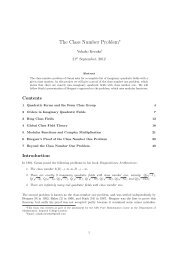
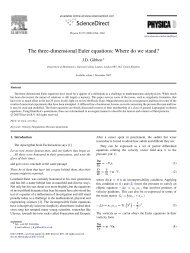
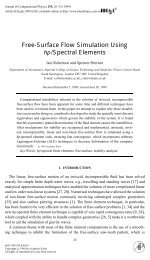
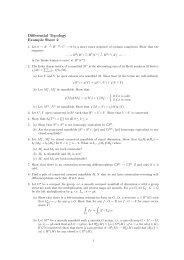
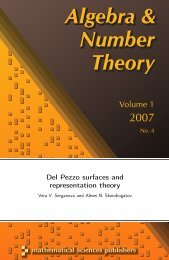
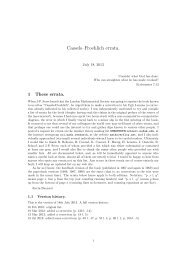

![Time Series (S8) 2012/2013 Coursework I: SOLUTIONS [1] (a) cov ...](https://img.yumpu.com/46239625/1/184x260/time-series-s8-2012-2013-coursework-i-solutions-1-a-cov-.jpg?quality=85)

